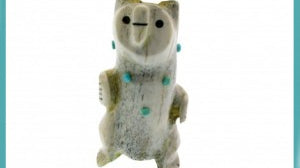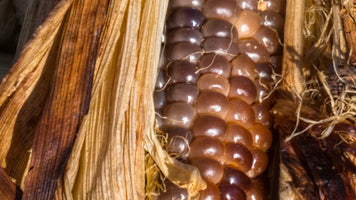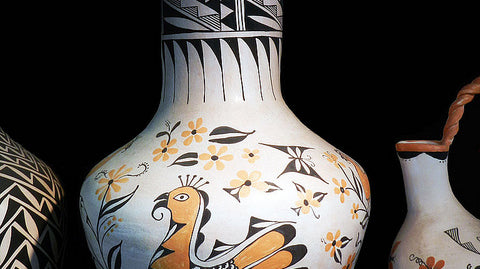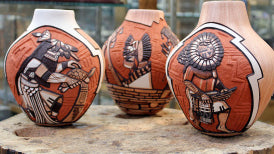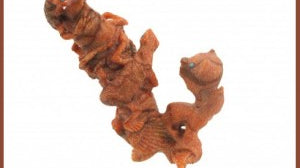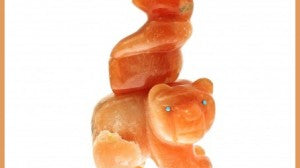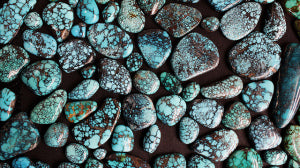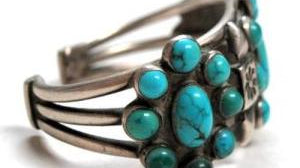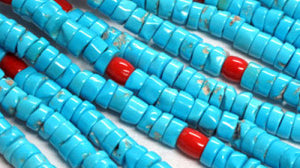Perry Null Trading
Deer Antler - Zuni Fetish Carving
Drive through the Four Corners area and you are likely to see mule deer, elk and antelope. Did you know that deer antler color can vary depending on the location the deer was harvested from? Variations are usually the result of the amount of oxidized blood left over from velvet shedding and the type of plant the buck uses to help shed it's velvet. The chemical reaction between the blood and sap present in the tree or bush used to rub the antlers can sometimes lead to interesting color variations.
Nampeyo Hopi Tewa Pottery
Though the First Mesa Tewa village of Hano has been occupied for more than three centuries and the people there have mixed freely with their Hopi hosts, Hano still maintains its separate Tewa language and cultural identity. Nampeyo’s father was a Hopi from the First Mesa village of Walpi. She spent a lot of time with her maternal grandmother who taught her the rudiments of pottery making. This would be the influence of Nampeyo Hopi Tewa Pottery.
Ganado Navajo Rug
In the beginning, in the time of creation, Spider Woman taught the Navajo the art of weaving. Spider Man taught them how to make their sacred loom.
Cluster Jewelry
There are few styles of Native American jewelry as iconic and classic as the cluster style. Bold and almost mythical in proportion, cluster jewelry is a way to present more stone on a single bracelet or belt buckle than otherwise possible. The patterns are not particularly innovative, but the symmetry and characteristic array of gorgeous stone is as eye-catching as any other form of jewelry.
Acoma Pottery
The Acoma Pueblo is one of the oldest still inhabited dwelling places in North America. Located approximately 80 miles west of Albuquerque, N.M., The "Sky City" of Acoma is perhaps one of the most beautiful and mystifying locations.
Hopi Pottery
Perhaps some of the most skilled Hopi artisans create a style of pottery called Hano polychrome or Sikyatki Revival. This pottery stands out amongst all of the pueblo and non-pueblo pottery makers as exceptional. The white wash with poly-chrome painting is some of the most recognizable art in the world.
Jet - Zuni Fetish Carvings
Jet is a beautiful black mineraloid. It's not a true mineral because it is made from organic material - decaying wood under intense pressure. Jet is found in the Four Corners area near the Acoma PuebloIt has been prized for centuries, the Romans used it believing it to have healing properties. It was especially popular during the reign of Queen Victoria in England who began wearing it as "mourning jewelry."
Apple Coral - Zuni Fetish Carving Material
Apple coral is part of the species of corals known as melithaea sponge, which is commonly found on the ocean floors around the waters of Taiwan, Indonesia and southern China. Some varieties of coral have been banned from mining and collecting due to the destruction of corral reefs around the world. Apple corral is not, however, included in this ban. Currently, this variety of corral is not endangered and environment-conscious jewelers and retailers have turned to it in leu of other endangered varieties. With continued global warming and the death of corral reefs this may change and apple corral may no longer be available.
Alabaster - Carved Zuni Fetishes
Alabaster is a fine-grained translucent form of gypsum that is typically white. Although white can be most common, the mineral can come with shades of red and orange. Alabaster is a name applied to varieties of two distinct minerals, when used as a material, gypsum and calcite. In general, but not always, ancient stones in Egypt and the Near & Middle East are calcite, and in medieval Europe are gypsum. Modern stones are probably calcite, but may be either. Both are easy to 'work' and as both are slightly water-soluble, have been used for making a variety of indoor artworks and carvings, as they will not survive long outdoors.
Chinese Turquoise
Turquoise has been mined in China for over two thousand years, which is evident by carvings from the earliest dynasties. Turquoise was never as popular in China as Jade. But here in the United States some of the finest turquoise sold over the last 25 years has come from China. Chinese turquoise ranges in color from a full spectrum of greens and light blues to a beautiful dark blue. Much of the material has a dark brown or black matrix and may also have a beautiful spider webbing. Some of the high-grade Chinese turquoise resembles and is thought to be equal to many of the better known or classic American Southwestern mines. Today turquoise in China is produced at the Maanshan mine northwest of Shanghai and mines in the Hubei province. Two of the finest mines in the Hubei province are the Yungai, which means, "a mountain covered with cloud" and the Zhuxi "a mountain where growing plenty of bamboo". The Yungai, or Cloud Mountain has produced natural turquoise that is equal to a number of the finer Nevada mines that are now closed. Mines like the Nevada Blue, Number 8, Blue Ridge and the famous Lander Blue.
Cerrillos Turquoise
The Cerrillos Turquoise mining district has been called the earliest and the most important turquoise mining area in the country. It is located in Santa Fe County in north central New Mexico between the towns of Santa Fe and Albuquerque.
Castle Dome Turquoise (Pinto Valley Mine)
Castle Dome turquoise, which has also been known as Pinto Valley, is a by-product of a copper mine located five miles west of Miami, Arizona. Much of Arizona turquoise comes from the copper mining operations, which are often continuations of old turquoise mines. The Castle Dome mine was originally opened in 1943 and developed by the owners as a war project. With the end of War World II and a low demand for copper the mine closed in 1953. Later the area was re-opened as the Pinto Valley Mine. Turquoise was widespread throughout with masses over one-half inch thick with colors ranging from sky-blue to bluish-green with the blue color being predominate.


